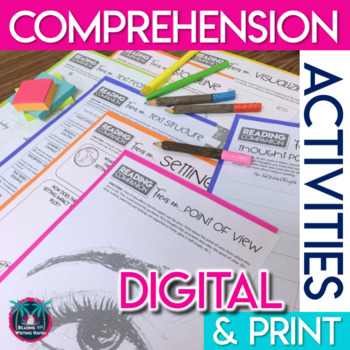Reading Comprehension Graphic Organizers for Any Fiction or Nonfiction Text
- PDF
What educators are saying
Also included in
- Do you want your students to think critically, thoughtfully, and reflectively about what they are reading? Are you in need of a way to scaffold literary analysis and reading comprehension? This huge reading graphic organizers bundle contains graphic organizers and activities that you can use with anPrice $32.00Original Price $39.48Save $7.48
Description
Looking for a way to assess students' reading comprehension and keep students engaged during read alouds, whole-class reads, guided reading groups, or independent reading time? These reading comprehension worksheets are perfect for middle and high school classes.
These activities will keep students focused on showing how they are thinking about fiction and nonfiction texts without overwhelming them. You can use these activities during and after reading.
They make for excellent conferring discussion points. You can also use them to ask students to reflect on what they have read or to monitor their thinking as they read or listen to the text. Use them as whole class, small group, independent, or literacy center station activities.
I suggest modeling how to use each page before asking students to do so independently. You can do this through a read aloud, think aloud, or minilesson.
Included, you will find 20 one-page prompts that focus on the following skills:
(*Note: These are not minilessons, but you can use them as such to model what good readers do by selecting a text and showing students how readers use each skill.)
1. Sequencing Events and Details - recognize order of events or important details
2. Summarizing - point out the important plot events or 5 Ws
3. Questioning - practice asking thoughtful questions as they read or listen
4. Connecting - make meaningful connections that deepen understanding
5. Inferring - combine schema and text evidence to make an inference
6. Mood and Tone - identify words that describe the tone and/or mood of the text
7. Predicting - make educated predictions and monitor them while reading
8. Visualizing - show how you think about a text
9. Storyline / Plot - make an educated guess about current plot location
10. Text Features - identify the text features and explain how they help readers
11. Text Structure - identify the text structure(s) and think about author's choices
12. Point of View - explain how the point of view impacts readers' understanding
13. Author's Purpose / Bias - identify the author's purpose and unstated messages
14. Setting - think about how setting impacts other elements of the story
15. Reader's Emotions - identify how you feel as you read or listen to the story
16. Color Symbolism - explain what colors best represent the readers' emotions
17. Thought Parking Lot - train students to "park" their thoughts to increase focus
18. Author's Craft - think about the role a sentence or passage plays within the whole
19. Word Choice - think about connotation vs. denotation and figurative vs. literal
20. Old vs. New - identify themes, characters, and plot patterns drawn on from traditional texts
These exercises are intended to be quick and concise ways for students to demonstrate their thinking so that teachers can gauge comprehension. They should be easy to complete in 10 to 15 minutes. You can also use them as a springboard for a longer written response to reading or class discussion.
BOTH DIGITAL AND PRINT VERSIONS INCLUDED!
IS IT EDITABLE?
This resource is not editable in that the font and clipart is secured on each Google Slides document. However, you can change the slide backgrounds, add additional slides, or remove some to fit your needs.
NOTE: This resource is also included in a larger bundle, Reading Literature and Informational Texts Graphic Organizer Activity Bundle.
Loving this? You can find similar reading products to use with any text here:
Discussion Task Cards for Fiction and Nonfiction Texts
Build a Reading Guide for Any Short Story
Scaffolded Activities for Informational Texts
And more here!
Stay in touch:
~~~~~~~~~~~~~~~~~~~~~~~~~~~~~~~~~~~~~~~~~~~~~~~~~~~~~~~~~~
A Couple Tips:
* Be sure to click the "follow" button that is located next to my picture so that you can hear about sales and new products!
* By providing feedback on your purchased products, you can earn points, which ultimately translate into cash toward future purchases...bonus! Plus, I'd love to hear from you.
©Reading and Writing Haven
All rights reserved by author.
Duplication limited to single classroom use only.
Electronic distribution limited to single classroom use only.






